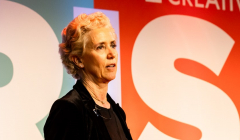
Diageo CMO on progressive media, AI and inclusivity
Speaking at the Creative Equals Rise conference, Cristina Diezhandino, Chief Marketing Officer at Diageo, lifted the lid on the brand's progressive marketing journey

The latest IPA Bellwether Report reveals that pessimism is widespread across the industry although growth, albeit slower, continues

The cost of living crisis has brought worries to consumers and had an impact that has rippled across all areas of business. While the advertising industry continues to hold growth, economic uncertainty has caused this growth to slow according to the latest IPA Bellwether Report.
The report reveals that total marketing budget growth has held steady for over a year but has slowed for a second successive quarter due to the rising costs of energy bills, political unrest and economic turbulence. In Q3, 22.2% of companies increased their total marketing budgets and only a marginally smaller proportion of companies registered marketing budget cuts (20.1%), resulting in a small positive net balance of +2.1% down from +10.8% in Q2.
Customers have experienced high inflation that has led to pressures around purchasing, in response to this some companies have reeled back marketing budgets to combat price increases and uncertainty.
The only category that saw growth in Q3 was events showing the heightened appetite for in-person events and meetings post pandemic. After media consumption levels were at an all time high during the pandemic, growth levels have dropped considerably and continued to stagnate.
The report shows that main media marketing budgets – which include big-ticket advertising campaigns relating to TV and radio – fell for the first time since Q1 2021 (-3.1%, from 0.0% previously). Within this category published brands (-11.2%, from -2.6%) and out of home (-7.6%, from -15.9%) saw the biggest drops while audio also fell slightly (of -2.0%, from -16.4%). However, online advertising (+9.3%, from +4.4%) and video (+8.7%, from +0.8%) saw growth.
The data found a stronger level of negativity among Bellwether firms towards the financial prospects of their specific industries. Just 6.3% of surveyed companies were more optimistic while 50.5% were downbeat.
Where recession sees many businesses cautious with their budgets, Paul Bainsfair, IPA Director General advises that “instead of slashing budgets that can lose brands their customers’ awareness and subsequent market share, our experts would advise that after optimising their pricing and promotions strategy, which would usually include supporting with brand advertising, companies tweak their brands’ marketing budgets subject to their geography, portfolio, channels and media – all of which will have variations that can also be optimised accordingly. Equally, we’d advocate a longer-term approach that steers away from heavy sales activations which can erode brand loyalty and lose companies profit.” Striking the right balance between long and short termism will reap the best results for businesses throughout the recession.
While pessimism is widespread, Bellwether authors S&P anticipate the recession to be short and shallow partially due to support measures provided by the Government to assist households and firms with their energy bills. This relief is likely to help sustain ad spend into the end of the year and as a result Bellwether has upwardly revised its 2022 adspend forecast to 3.7%, from 1.6% previously, leaving advertisers something to feel positive about as we enter 2023.
Looks like you need to create a Creativebrief account to perform this action.
Create account Sign inLooks like you need to create a Creativebrief account to perform this action.
Create account Sign in